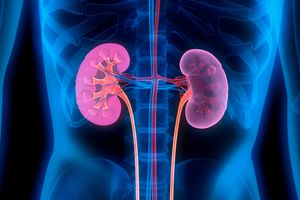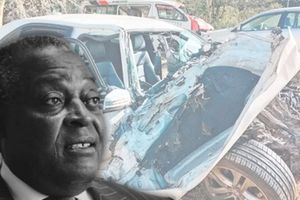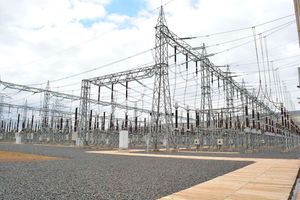New kidney dialysis technology offers patients better outcomes
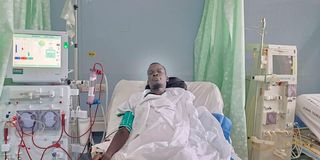
Victor Onyango , a chronic kidney disease patient, undergoing dialysis at Jaramogi Oginga Odinga Teaching and Referral Hospital using the newly acquired Online Hemodiafiltration machine.
What you need to know:
- Victor and Grace are among the four million Kenyans living with kidney disease as per the latest data from the Kenya Renal Association.
It’s 10am. When the Healthy Nation team arrives at Jaramogi Oginga Odinga Teaching and Referral Hospital in Kisumu, it’s a beehive of activity. At the renal clinic, tens of patients are lining up waiting to use the kidney dialysis machine.
Inside the renal wards, a nurse has just placed a patient on the dialysis machine. The procedure, she says, will be completed in four hours’ time.
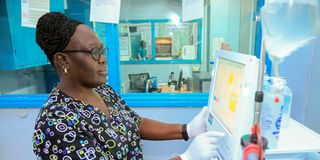
Pamela Adhiambo, the renal unit nurse in charge at Jaramogi Oginga Odinga Teaching and Referral Hospital, observing an online hemodiafilration machine at the hospital on February 2, 2025.
Seven other patients are tucked in their respective beds, each connected to a dialysis machine that serves as a lifeline. Hospital staff are serving meals to patients who just cleared their routine dialysis session, while doctors are going round monitoring patients.
This is the daily routine of the renal clinic, which attends to at least 25 dialysis patients per day.
Among those on the queue is Victor Onyango, who says he was at the facility at 8am.
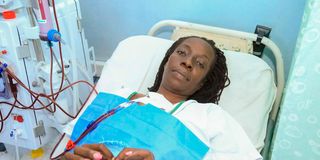
Ms Grace Atieno lies on a hospital bed during a dialysis session at Jaramogi Oginga Odinga Teaching and Referral Hospital.
“I have been booked for a dialysis session at 2pm. Those who are being served now arrived as 6am,” says Victor, 30.
The resident of Nyahera in Kisumu County tells Healthy Nation that he has been using the dialysis machine since January 2020 when he was first diagnosed with chronic Kidney disease (CKD).
Before the diagnosis, Victor had been battling hypertension for close to three years.
He explains that in 2018, he had been struggling with constant headaches, shortness of breath and dizziness, which he says were symptoms similar to those that his late grandmother had displayed after she was diagnosed with high blood pressure.
He would later visit Jaramogi Oginga Hospital, where he was diagnosed with hypertension. He was placed on a daily medication, but he admits to only taking the drugs whenever he felt unwell.
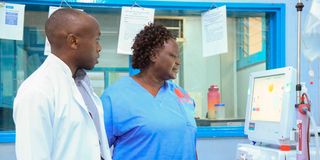
Dr Florentius Ndinya (left), a consultant physician and nephrologist at Jaramogi Oginga Odinga Teaching and Referral Hospital, observing a dialysis machine alongside Nancy Nyakiti, a medical expert, at the facility.
In January 2020, he was rushed to the hospital after developing a severe headache. His face and feet were also swollen.
The health worker attending to Victor realised that his blood pressure was extremely high. Further tests revealed that his kidneys had failed.
According to the doctor, Victor could have developed chronic kidney disease due to the fact that he had hypertension.
“I was also informed that since both my kidneys had failed, I needed a transplant. My family, however, could not meet the cost. The next solution was to be placed on a dialysis machine,” says Victor.
He explains that he attends kidney dialysis twice a week, on Mondays and Thursdays.
Until January 30, Victor had been utilising the conventional hemodialysis machine at the hospital. He, however, admits that the use of the equipment came with a number of challenges.
“Every dialysis session would result in muscle cramps, especially around my joints. The sessions also left me extremely fatigued.”
But the narrative has changed.
In January this year, Jaramogi Oginga Hospital launched seven Online Hemodiafiltration (HDF) machines in an effort to better renal care among kidney patients. The machines represent a major step forward in dialysis technology, offering improved treatment options for patients with kidney failure.
Jaramogi Oginga becomes the third facility after Moi Teaching and Referral Hospital and Nairobi Hospital to adopt the new technology.
Dr Florentius Ndinya, a consultant physician and nephrologist at Jaramogi Oginga Hospital, says before the introduction of the new machine, the facility, just like other hospitals across the country, depended on the conventional hemodialysis machine for the management of CKD patients.
According to Dr Ndinya, the conventional hemodialysis machine follows the same principle of online HDF of removing waste and managing acidity in the body in a process known as diffusion. But the process was restricted to filtering out smaller particles of waste from the body.
“The major difference we have when using online HDF is that the new technology works through a convective process that allows even larger groups of toxins to be removed from the body with ease,” says Dr Ndinya.
He adds: “The conventional hemodialysis machine can remove toxins, but up to a certain level. The new technology, on the other hand, removes slightly more toxic waste, what we consider slightly larger molecular waste toxins.”
The health expert explains that studies in the past have shown that the new therapy, if given in the right doses, has the potential to prolong lives of patients compared to the conventional hemodialysis procedure.
He further explains that patients using the new technology often feel much better due to improved clearance of waste, feel more energetic and generally have an improved appetite.
“Most of the patients utilising the machine have less complications such as low blood pressure. They tend to be hemodynamically stable” he says.
Victor, who had used the conventional machine for four years, says he is yet to experience any muscle cramps since he started using the online HDF machine in February this year.
He adds that his appetite and energy levels have since improved.
Dr Ndinya notes that the new machine boasts of advanced volume control and precision in fluid management, ensuring a more balanced and safer treatment process. He adds that this is one of the reasons Victor no longer experiences muscle cramps.
Among those already placed on the machine is Grace Atieno, who has been on dialysis for the last seven months.
Grace, 42, explains that she was diagnosed with kidney disease in 2020 after losing her unborn baby. However, she notes that she started experiencing symptoms of the disease 16 years ago.
It all began in 2008 when Grace walked into a health facility in Kisumu to deliver her first born child. Her blood pressure was extremely high. Further medical tests revealed that she had renal cysts, a fluid collection in the kidney.
After discharge, the new mother was doing well healthwise and thus paid little attention to the cyst.
In 2020, Grace, who was pregnant the second time, was rushed to a health facility only to learn that her unborn baby had died. Doctors would later explain that she had high blood pressure due to the renal cyst, resulting in the loss of her unborn baby.
“I was then placed on kidney disease drugs for a couple of months,” she says.
Seven months ago, Grace was referred to Jaramogi Oginga Hospital, where medical tests confirmed that her kidneys had failed.
The doctors advised that she had to either undergo a kidney transplant or start using the dialysis machine.
“Initially, after the four-hour dialysis session, I would feel fatigued and lose appetite.”
But all that is history now.
Grace notes that the introduction of the new machine at the facility has had a major impact on her health.
“I am feeling much better now. My appetite has also improved,” says Grace a few minutes after completing her dialysis sesssion.
Victor and Grace are among the four million Kenyans living with kidney disease as per the latest data from the Kenya Renal Association.
The association notes that the number is likely to increase to 4.8 million by 2030.
Globally, the National Kidney Foundation estimates that 10 per cent of the world’s population is affected by chronic kidney disease; while millions die each year due to poor access to affordable treatment.
The International Society of Nephrology estimates that more than 850 million people are battling various kidney conditions globally.
At Jaramogi Oginga Hospital, the renal unit nurse in charge, Pamela Adhiambo, says at least 25 renal patients attend kidney dialysis at the facility every day.
She adds that a couple of other kidney patients seek outpatient services at the facility.
Each patient attends dialysis sessions twice a week. “Even with the new machine, the frequency of coming to the hospital remains the same, but the outcome is different as expressed by our patients,” she says.
Ms Adhiambo says the Social Health Authority covers Sh10,600 dialysis cost per session for patients registered under the insurance scheme.
Dr Ndinya describes kidney failure as a condition that results from the body organ not being able to carry out its normal functions.
The kidney, he says, acts as a filter in the body. The organ eliminates toxic wastes, controls water volume and balances the body’s metabolism, among other functions.
The medical expert explains that kidney disease can either be acute or chronic; depending on the causes and the stage of infection.
Acute Kidney disease, he says, occurs over a short period. It can be caused by a variety of factors, including infections, dehydration arising from a prolonged bout of vomiting, or a sudden drop in blood pressure, especially due to loss of blood during delivery.
The medic adds that hypertension and diabetes are the primary drivers of CKD. Other causes says include cervical cancer, prostate enlargement, overuse of antibiotics, use of certain herbal medicines and terminal illness.
“Kidney disease is projected to be on the rise, particularly in the African set-up due to the increasing cases of hypertension and diabetes,” says the expert, adding that individuals with obesity also have higher chances of developing the condition.
He notes that a major setback to kidney management and treatment is the fact that many patients find out they have the condition at advanced stages because of its ‘silent’ nature. He adds that the patients only discover they have kidney disease incidentally, often when they visit a hospital for unrelated symptoms or conditions. By the time tests reveal kidney failure, the disease is usually in its advanced stages, making treatment more challenging
The common symptoms of chronic kidney disease include swelling of legs and areas around the eyes especially in the morning.
Other symptoms include hypertension, stroke and heart attack. According to Dr Ndinya, it is easier to identify the symptoms during routine medical check-up.
“If diagnosed early, some of the symptoms can be managed without progressing to kidney failure.”
Dr Ndinya explains that CKD patients go through five stages of the disease. Stage one is associated with mild symptoms while at the fifth stage, one displays severe symptoms.
Ms Adhiambo notes that with regular screening, a CKD patient diagnosed before the third stage can be placed on medication that slows down the progression of the disease.
At stage four, she says the patient requires additional support to clear toxins in the body, and this can be done either through dialysis or kidney transplant.
She, however, explains that on most occasions, dialysis remains insufficient due to the fact that patients undergo the sessions only twice a week, yet a normal kidney should work continuously, 24 hours a day.
She adds that the best treatment for kidney failure is transplant, which requires a patient to get the organ from a matching donor.
She, however, explains that many patients are unable to undergo the procedure due to financial constraints, failure to get a donor or patients battling other underlying medical conditions, among other challenges.
Such patients, she says, largely depend on dialysis to clean their blood by filtering out impurities in exchange with important substances in the body such as electrolytes.
According to Dr Ndinya, the online HDF machine will go a long way in improving the quality of life for patients battling CKD by giving them better treatment outcomes.
“Not every CKD patient is a transplant candidate due to a number of challenges. For those who are unable to undergo a transplant, our role as experts is treating them with better outcomes, and the new machine will enable us to achieve that.”
The renal expert says while the government has done a lot in terms of improving access to renal services, there is a need to have specialised healthcare providers to attend to patients in both high and low level hospitals.
The experts at low level facilities, he says, can screen and refer the patients to tertiary centers for specialist care.
Dr Ndinya also emphasises that there is a need to create awareness on screening of individuals, especially those in the viable group (people with diabetes, hypertension and obesity), for early detection of the medical condition.
“Early detection through screening is likely to prevent the need for renal replacement therapy. This is because the symptoms of the condition tend to be silent until at an advanced stage.”
He adds that there is a need for individuals to adopt healthy lifestyles to prevent a number of medical conditions.
“We also need to make transplant and post-transplant services available and accessible to patients. Dialysis is just a bridge to renal transplant, it is not a cure.”

